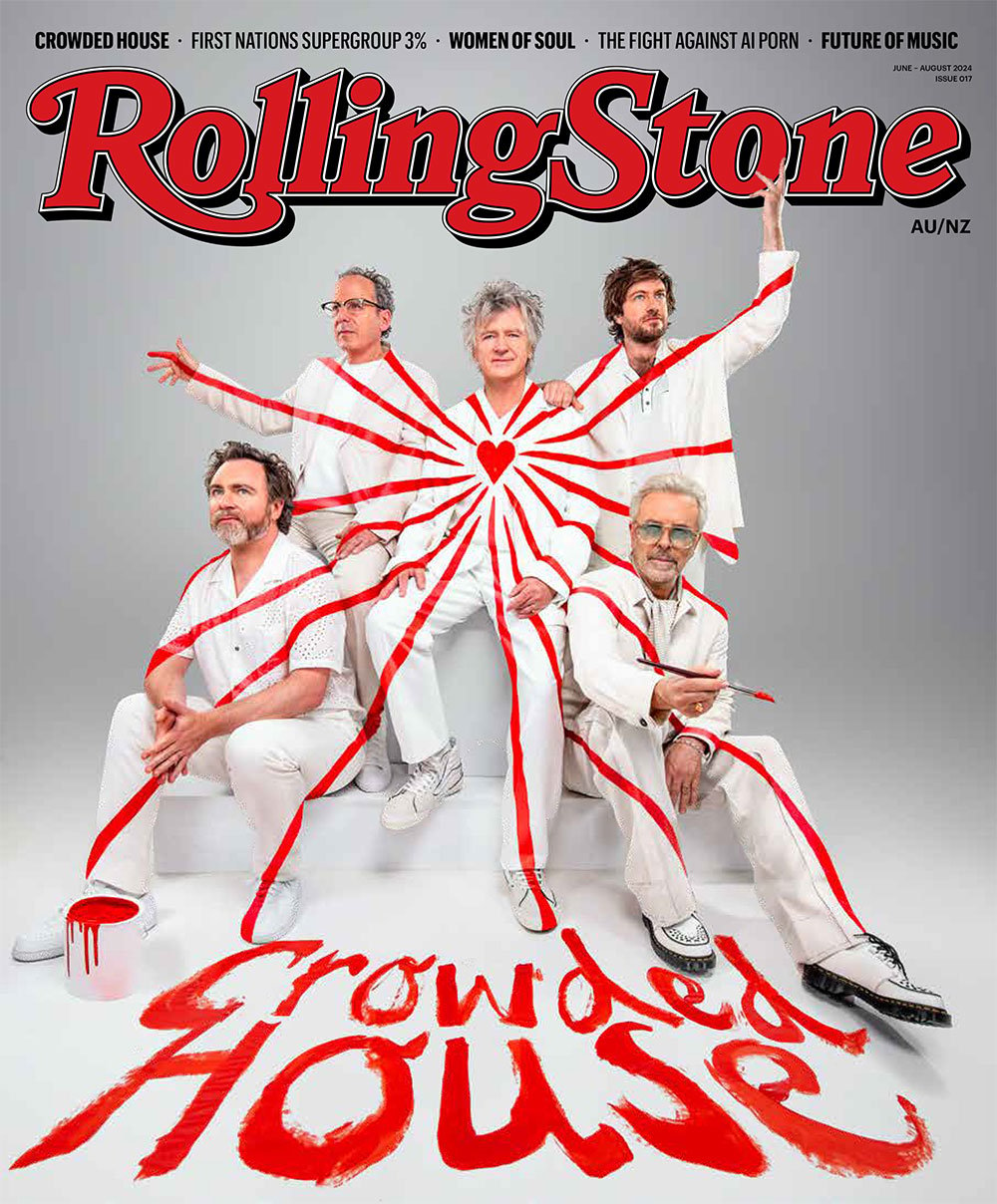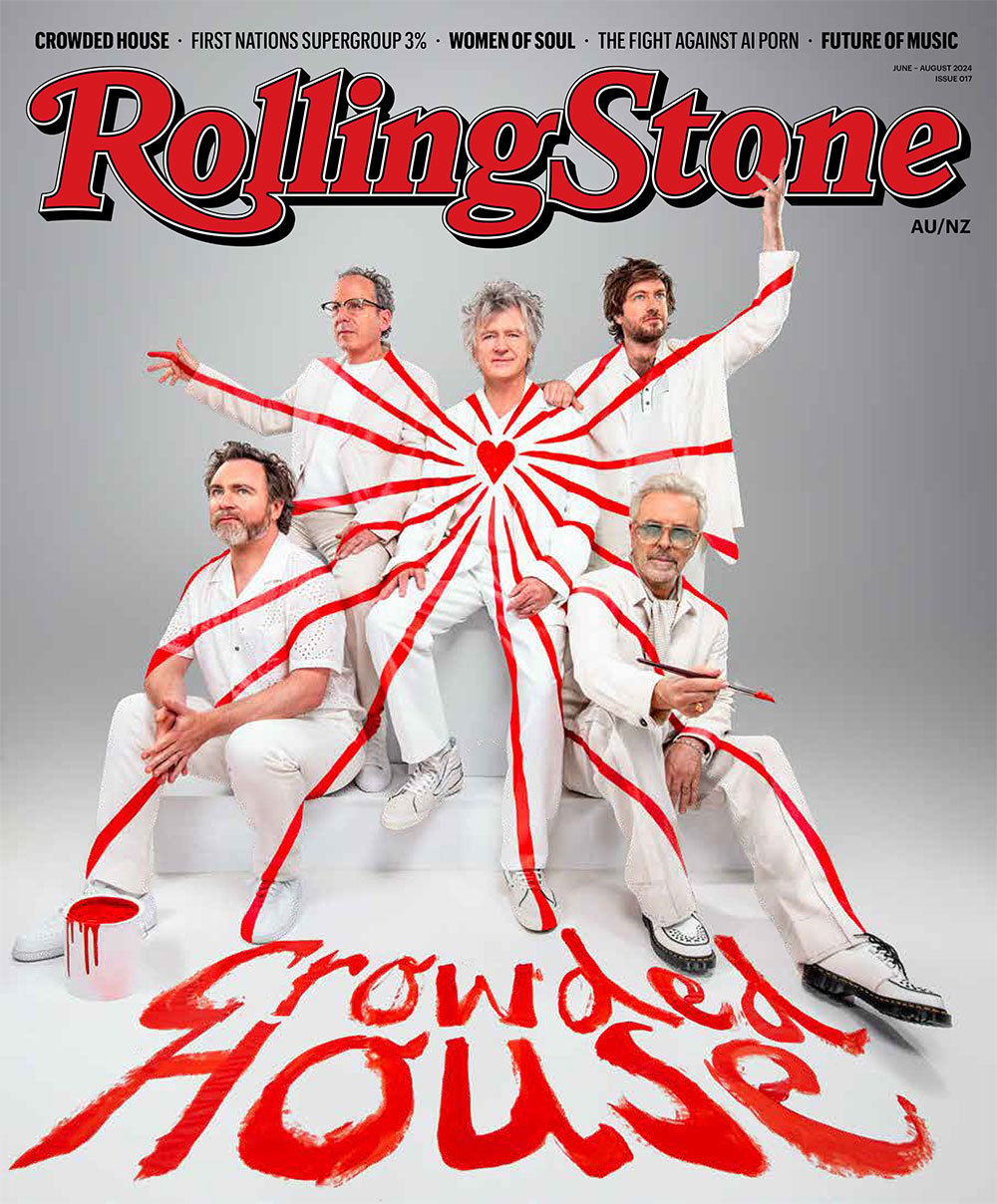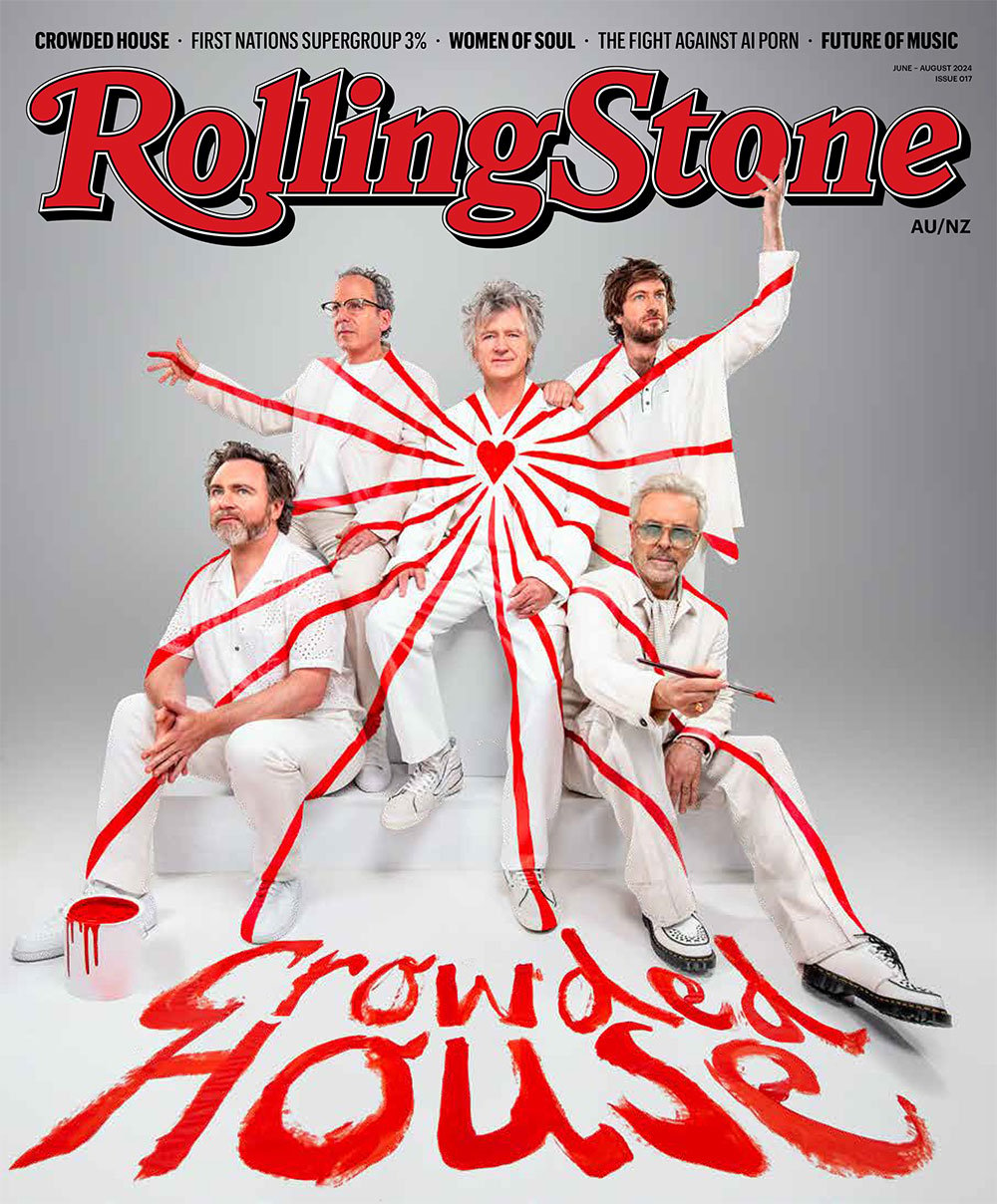In their book, For Whom the Cowbell Tolls: 25 Years of Paul’s Boutique, published by 6623 Press, authors Dan LeRoy and Peter Relic dive deep into the backroom arcana and recording studio hijinks surrounding the Beastie Boys’ greatest album. In this excerpt, a piece of musical history is found sitting undisturbed on a shelf in a Los Angeles storage facility.
The reel sat in storage for nearly 25 years.
There was no mistaking the writing on the box, penned in Sharpie in black block letters: BEASTIE BOYS #1. This did not refer to the band’s chart position at the time, or their place in the hearts of fans. Handwritten by engineer Mario Caldato, Jr., the stick-on label indicated that the box contained the first reel of tape from the Paul’s Boutique sessions that took place in Matt Dike’s Hollywood apartment in the spring of 1988. The list of contents was tantalizing: CAUGHT, SCRATCH ME, YACH, FULL CLOUT, SHADROCK, BLUE NOTE. Aside from the recognizable working titles for songs that would appear on Paul’s (and the fact that Caldato had yet to learn the proper spelling of Adam Yauch’s surname), this was like being smacked in the booty with Indiana Jones’ bullwhip. This was, perhaps, the ark of the Beastie covenant.
By the summer of 2013, the corrugated cardboard box of Ampex Grand Master 456 half-inch tape was resting amongst similar boxes on a shelf inside a public storage facility in West Los Angeles. The storage unit was being rented by Michael Ross, who co-founded record label Delicious Vinyl with Matt Dike in 1987. In the process of cataloging the label’s archive in advance of a Delicious Vinyl box set, Ross handed over the keys to the storage facility. “There’s probably boxes of old press releases and newspaper clippings in there that might help with research,” he reasoned. “Have a look.”
The storage space did indeed contain molting, mountainous testament to the deluge of media attention that Delicious Vinyl received in 1988 and 1989 as the label scored surprise hit singles “Wild Thing” and “Funky Cold Medina” by Tone-Loc and “Bust A Move” by Young MC. There were lots of original tapes there too, documenting work by Delicious Vinyl artists. And then there was the Beastie Boys reel. The implications of the tape’s existence were significant. But what, exactly, was on the tape?

Mike D. holding lost tape of lost Beastie Boys’ recordings. (PHOTO: Peter Relic)
Showing up for the first day of work can bring a knotty mix of optimism, determination and trepidation. It was no different for the Beastie Boys when they arrived at Matt Dike’s apartment to begin recording the follow-up to their 1986 debut album Licensed To Ill.
Set above an oil-fumed carburetor repair shop along a sketchy stretch of Santa Monica Boulevard, Dike’s apartment was no crappier than Chung King, the NYC Chinatown studio where the Boys made Licensed To Ill. After the success of “(You Gotta) Fight For Your Right (To Party),” the Madonna tour, the U.K. tabloid brouhaha, MTV Spring Break shenanigans and the first rap album ever to go to Number One on the Billboard pop charts, presumably the Boys could opt for opulence when it came to make a follow-up. But money can’t conjure magic and anyhow the Boys were in contractual purgatory between their blighted Def Jam deal and the beaucoup Capitol Records contract yet to come.
Expecting the Beasties’ imminent arrival, Dike left the door to the street unlocked. Bordered with art deco blue-and-yellow tile, the door led to a steep, narrow staircase and then a small landing. Up another flight was a modest foyer, then straight ahead a walk-in closet. Deep enough to house a Shure microphone clipped to a silver stand, its walls and ceiling stapled with mottled green carpet scraps to baffle the sound, the closet was the isolation vocal booth for what was colloquially known as Delicious Studios, where Tone-Loc and Young MC had laid down the vocals for their chart-frosting hits. In the commentary track to the 20th anniversary release of Paul’s Boutique, Ad-Rock observed: “They blessed the closet.”
Dike played the Beasties a beat he’d made for them, to get them excited to record again, to inspire them to rhyme over the super-saturated break-beat fantasia quilted together for especially this moment. Horovitz recognized a bit in a track that’d somewhere down the line get named “Hey Ladies”: “Yo, that’s ‘Shake Your Pants’ by Cameo. Cameo is def!”
Then Dike’s Delicious Vinyl partner Mike Ross walked up the stairs. Ross was dressed confidently in young executive style: shiny sport coat over open-necked dress shirt, tennis-hero blonde mane blow-dried to perfection. Ross saw the Beastie Boys standing around, looked at MCA, then pointed at the closet and said, “Get in there and bust a rhyme!’ “Why don’t you go fuck yourself,” was Yauch’s friendly rejoinder. And with that, Mike Ross’ potential involvement in the creation of Paul’s Boutique was over before it started.
To ease the mood, Dike threw a familiar break onto the turntable: “Bonzo’s Montreux,” the monstrous drum solo from Led Zeppelin’s Coda. Mario Caldato had already threaded a reel of tape through the machine and pressed record. What commenced was not quite a song and more of freestyle, as the Beasties tried out fillips and quips (“writin’ down lyrics in the back of the cab / standin’ on the corner waiting to get stabbed”) and a blast at Def Jam boss and estranged pal Russell Simmons (“you try to keep the louie / you don’t pay the band / you should’ve never messed with the egg man”) as Dike sloppily scratched in the slide guitar from the Steve Miller Band’s “The Joker.”
Just past the three-minute mark, the routine petered out. This track – the one titled CAUGHT on the reel – was an intriguing icebreaker, but sounded more like an outtake from Licensed To Ill then anything resembling what finally appeared on Paul’s Boutique.
Dike realized that Beasties were ready to record, but that they had almost no complete lyrics. “Y’know, I love that line on ‘Hold It Now, Hit It’,” Dike announced, “where you go ‘I’m Mike D and I can do it very Jewish!‘” After a moment of collective stupefied silence, Mike D sputtered, “Not ‘very Jewish,’ it’s ‘Jerry Lewis’! But ‘very Jewish’ – that’s pretty good too.”
“Hey, yo Mike! Let’s do the Jerry Lewis!” Ad-Rock chimed in.
“My baby does the Jerry Lewis!” countered Mike D.
MCA and Ad-Rock joined in the chant, which to Matt and Mario sounded like the chorus of a very catchy song.
“I’ve got the perfect beat for this,” offered Dike, disappearing into the bathroom. He emerged brandishing a copy of the album Memories Are Made of This by Dino, Desi & Billy, produced by the legendary Lee Hazlewood. Dike quickly cued up side one, track four: “Baby Scratch My Back,” Dino, Desi & Billy’s verbatim cover of Slim Harpo’s Number One soul single from 1966. While Dino, Desi & Billy’s vanilla vocals drain every possible entendre from Slim Harpo’s version, their rendition isn’t totally musical milquetoast: it features fabled Elvis accomplice Billy Strange adding a hypnotic guitar line, over a lazy beat and a forceful snatch of honky-tonk harmonica.
Bubblegum teenagers Dino, Desi and Billy were scions of Hollywood royalty, two of them anyway: Dean Paul “Dino” Martin was the son of louché Rat Packer Dean Martin and Desiderio “Desi” Arnaz IV the offspring of I Love Lucy‘s Lucille Ball and Desi Arnaz; Billy Hinsche was their Beverly Hills buddy. Whatever their debatable musical bona fides, Dino, Desi & Billy were – not unlike the Monkees – the faces and voices of a studio creation.
Dino, Desi & Billy’s version of “Baby Scratch My Back” was recorded United Western Recorders on Sunset Boulevard, only a few blocks north of the apartment where Dike and the Beasties began work on Paul’s Boutique two decades later. Legendary as the studio where the Beach Boys created Pet Sounds, the birthplace of the Mamas & the Papas’ “California Dreamin’,” and countless immortal hits, United Western Recorders retained its reputation even after it changed ownership in 1984. Post-sale, the studio was renamed Ocean Way. In a little psycho-geographical twist, it was to Ocean Way that Beastie Boys decamped to continue work on Paul’s Boutique after the key early sessions at Dike’s apartment. The vibe was right.
Dealing with old recording tape is a tricky. If not handled properly, old tape is in danger of dying from “sticky-shed syndrome,” the tape spitting up bits of its deteriorating self when played.
For transferring, the Beastie reel was placed in the hands of Charles Laurence, engineer, producer, and vintage gear head, a man with the Jerry Lewis spirit in his genes. Laurence worked with Harry Nilsson in the Eighties, and his naturally ebullient disposition must have come in handy when recording Nilsson’s indulgent marathon sessions. Located deep in the San Fernando Valley, Laurence’s Porter Ranch home is surrounded by thatched porches housing endless exotic fishtanks; inside, his collection of gear runs from a 78-rpm lathe to a TOM sequential drum machine.
After subjecting the tape to a restoration process called “baking,” Laurence transferred its contents through a DBX noise deduction unit identical to the one that the engineer, Caldato, used on the original recording.
Thus “The Jerry Lewis” came back to life, beginning with the sound of rustling paper and MCA saying: “It’s better now.”
As the hypnotic portion of Dino, Desi & Billy’s “Baby Scratch My Back” played, the Beasties climbed into the closet and paid tribute in rhyme:
Push up ya head, shake your rump
It’s not the hustle it’s not the bump
It’s the Jerry Lewis, the brand new dance
A national pastime, he’s a king in France
The jerk, the patsy, Robert DeNiro
He is our man, he is our hero
I hate rods, I can’t rock latches
You know the song, y’know what the catch is!
The Jerry Lewis
The Jerry Lewis
The Jerry Lewis
The in-joke of “The Jerry Lewis” is that Jerry Lewis had been the longtime comedic partner of Dino’s dad Dean Martin. The Beasties picked up on Dike’s sensibility immediately.
The song belongs to the goober milieu of Licensed To Ill, with one prime difference: it was produced by Matt Dike, not Rick Rubin. Its gummy funk is pure Paul’s Boutique, its lyrics simple and funny and catchy, the most almost-innocent thing Beastie Boys ever recorded. With Paul’s Boutique, the Beasties’ intention wasn’t to make hit singles, but to create great art. One reason “The Jerry Lewis” was shelved must have been because of its pure catchiness. It was, simply, the massive hit single that Paul’s Boutique intentionally lacked. Instead, like a warm-up suit shorn when it’s time for tip-off, the song was put in a box and forgotten about. Yet its playfulness defined a key element the Paul’s aesthetic: it was an inside joke, but not one that limited anyone’s appreciation of the record.
Capitol higher-ups expected the Beasties to deliver a hit. Their A&R man, Tim Carr, had presented the Boys with the so-called “Jumpin’ Jack Flash” memo, which made the comparative case that the Rolling Stones were pigeonholed as a novelty blues band until they created their crossfire hurricane hit in 1968. Capitol was saying – pleading – that the Beasties could make a new smash single without compromising their integrity. Their plea fell on deaf ears.
Which is, probably, a good thing. If Capitol execs had ever heard “The Jerry Lewis,” they would’ve immediately opened a new Swiss bank account. Had “The Jerry Lewis” been released as Paul’s Boutique‘s first single ahead of the under-performing “Hey Ladies,” Beastie Boys would likely have been permanently pegged as novelty knuckleheads, never to go on their long, strange journey.
“If ‘Jerry Lewis’ was mixed down and released tomorrow, it would be a worldwide Number One,” says Matt Dike today. “It kind of gives me a hard-on just thinking about it.”
In late 2013, the reel was presented to Mike D, whose response to “The Jerry Lewis” was, “That’s just an idea we had.” Upon listening, Mike blinked: “Oh, it’s the whole song.”
It’s ripe for release, Mike.
“Probably not this year.”
Twenty years after they recorded “The Jerry Lewis” in Matt Dike’s dusty apartment, the song hadn’t faded from the Beasties’ minds. Far from it. On June 10th, 2009, the band played a date in Asheville, North Carolina at a club called the Orange Peel. (It was a warm-up for their performance at Bonnaroo on June 12th, 2009 – the final Beastie Boys show ever.) The Orange Peel is a 1,000-person capacity venue, and the Beasties were having fun that night, a little goofier and looser than a lock-tight festival appearance allows.
There are two videos taken by fans at the Orange Peel show. Each captures, from a slightly different angle, the impromptu moment where the Beasties almost do “The Jerry Lewis.” With Mike D looking on and MCA hanging back slightly with a gum-chewing grin, Ad-Rock steps to center stage and signals for silence. He wants to demonstrate some dance steps.
First Ad-Rock does the Funky Penguin, a loose hop-skip from side to side. This he follows with a snatch of the Jerry Lewis (lips pursed, mid-section stiff, arms akimbo) while at Mike D’s behest Mixmaster Mike drops “something to dance to” — the break from Average White Band’s “Person To Person.” The crowd hoots in appreciation as Mike D mimics Ad-Rock’s dance steps and asks, “How’s the song go though?” Ad-Rock turns and together they holler: “The Jerry Lewis!” Yauch cracks up: “Good shit, man!” Mixmaster Mike then drops the intro to “Shake Your Rump” and the Beasties dive back into their set.
Basically a refashioning of of the Tommy James & The Shondells’ Number One from 1966, “Hanky Panky,” “The Jerry Lewis” finds the Beasties turning the original’s insipid chorus, “My baby does the hanky panky,” into the even-more-insipid “My baby does the Jerry Lewis!” The question is: Why exactly were Beastie Boys taking the time to create an entire song dedicated to Jerry Lewis? Sure, the Boys had plenty of routines that were done for no reason other than to amuse themselves. But in this case their devotion meant something more.
One thing that Jerry Lewis detractors often miss — or just don’t get — is that Jerry Lewis is mad funky. Not for nothing did Funkadelic majordomo George Clinton once appear on Lewis’ Muscular Dystrophy Telethon. L.A. music ‘zine FUNK ran a cover story on Clinton, along with a probing interview and all new photos. A copy of the black-and-white, Xeroxed-and-stapled ‘zine has stayed in Matt Dike’s collection ever since. The issue’s back cover? A photo of Jerry Lewis.
The Jerry Lewis was, along with the Smurf and the Popeye, a dance done in punk rock clubs back in the Beasties’ teenage heyday. Jeremy Shatan, who grew up with Mike D and shot Paul’s Boutique’s panoramic album cover photograph, has this to say: “I was never a fan of the Martin-Lewis duo, or the Jerry Lewis comedy style. One aspect of Mike and his brother Stephen was that they liked these kinds of low-class things. They’d get off on stuff like Mr. T, you know? So maybe Jerry Lewis fit in, in a way. You can’t tell if the guy’s an idiot, or is he an idiot savant? He sort of makes you uncomfortable in some of those early movies. Is there something wrong with this guy, or was this an astonishing performance? Does he know what he’s doing? I could imagine that aesthetic in the studio, when they were making the record.”
Beyond the qualities that Shatan mentions, one element that the Beasties innately responded to in Jerry Lewis’ comedic demeanor is Jewishness. Like Lewis, Beastie Boys belong in the comedic tradition of often goofy, deceptively-dumb humor personified by Jewish geniuses like the Three Stooges, Mel Brooks and Buddy Hackett. Like the Beasties’ oeuvre, there’s nothing explicitly “Jewish” about Jerry Lewis’ work, with one crucial, pertinent exception.
The Day the Clown Cried is a legendary film in cinephile circles, for the simple reason that the public has never seen it. In 1972, Lewis directed and starred in the film, set during World War II, about a fictional German circus clown named Helmut Doork. Sent to prison for mocking Nazis, Doork is soon shipped to a concentration camp where he is forced to perform for children about to die in the gas chambers. Upon completion of filming, the movie was shelved, and The Day The Clown Cried has never been released or even circulated in bootleg form. However, in the summer of 2013, footage appeared on YouTube from a 40-year-old Flemish documentary about the making of the film. This prompted Entertainment Weekly to run a new piece revisiting a previous interview with Lewis where, when asked about The Day the Clown Cried, the actor claimed that the film was “so deep that when I did what I know best – the comedy – it completely got away from me.” Confused, Lewis phoned his father: “I called my dad because he’s my mentor, he knows about every breath I take that’s comic. He said, ‘What do you expect, schmuck?’ The one thing that really impressed me was [he told me], ‘You’re not gonna be free to dance your funny dance in this project.’ Dance your funny dance…. So when you come up against that, you know that you have a problem.”
As for Beastie Boys, they no longer wanted to dance their “funny dance” – at least not the same steps they’d delivered on their debut album.

The original ‘Paul’s Boutique’ rhyme book, featuring mention of Jerry Lewis’ telethon (PHOTO: Courtesy Matt Dike)
In a sense, The Nutty Professor is Jerry Lewis’ Licensed To Ill: an enormously successful, broad-stroke, tough-to-top hit. With the possible exception of The King Of Comedy, The Nutty Professor remains Lewis’ best-known, most beloved film. Released by Paramount Pictures in 1963, the earthbound sci-fi comedy stars Lewis as Professor Julius Kelp, a bumbling, bucktoothed chemistry nerd, the antithesis of cool. One day, while minding the burbling beakers and Bunsen burners in his lab, Professor Kelp receives a message that he’s to be a chaperone at a student dance. Panicked, he turns to his sidekick, a pet parrot with a girl’s name: “What am I to do, Jennifer?” “Have you ever thought of taking poison, Julius?” responds the parrot.
Luckily, Professor Kelp is not without a plan, which is to say a serum. He ingests it, and transforms into his ultra-suave alter-ego, the debonair boho-hipster Buddy Love, who happens to have a strong taste for a killer cocktail called the Alaskan Polar Bear Heater. That evening, as the students happily, chastely dance to a swing band, Kelp/Buddy begins twitching on the sidelines. Then, as his fellow chaperones look on in horrified disapproval, he begins to dance.
His moves delighted teenage punks the Beastie Boys. They copied them, and called it the Jerry Lewis.
Top photo: Mario Caldato, Jr. & Beastie Boys recording Paul’s Boutique. (CREDIT: Ricky Powell / Rock Paper Photo)




























